|
MICRO
PLASTICS
ABOUT - CLIMATE
CHANGE - CONTACTS - FOUNDATION -
HOME - OCEAN
PLASTICS
PLEASE
USE OUR A-Z INDEX
TO NAVIGATE THIS SITE

OREGON
SEA GRANT - Funding from
this charity allows Portland State University researchers to
carry out this important work aimed at quantifying the harm
that micro plastic is causing to the seafood that we eat. Do
you speak ocean?
It's
not just plastic bags and bottles at our supermarkets,
micro plastics are also released every time we wash our
clothes, as the waste water
flushes into our sewers and out to sea. Tumble driers release
micro fibres into the air that also find their way into our
ecosystems and around the home in the air
we breathe.
As
with any problem there is a solution, once the problem has
been identified. As with diesel engines and their particulate emissions,
washing machines could be fitted with water filters and tumble
driers with air filters. How these add-ons might be
incorporated economically is another stage of the development
of man in his plastic civilization - but well worth the effort
for the health of our children in the plasticene
age.
WASTE
MANAGEMENT WORLD 10
SEPTEMBER 2017 - IMPACT OF MICRO PLASTIC ON OREGON'S
SHELLFISH
The impact of extremely small particles of waste plastics on Razor Clams and Oysters along the Oregon coast is being investigated by researchers at Portland State
University.
To conduct the research the group has secured funding from Oregon Sea Grant - one of 33 state programs within the
National Oceanic and Atmospheric Administration's
Sea Grant College Program, which is funded by federal and state appropriations, as well as project-specific contributions from local governments and industry.
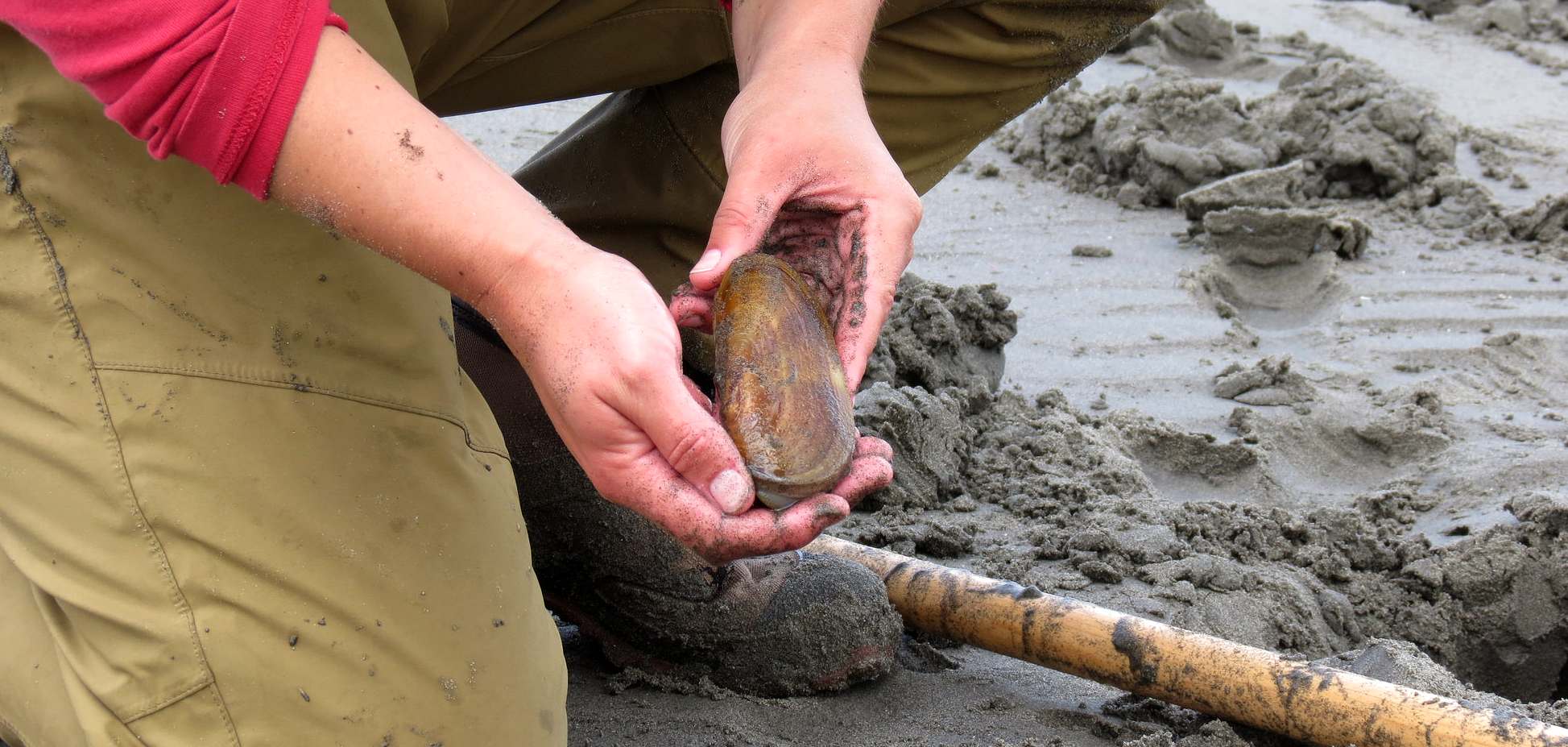
The researchers explained that the microplastics can come from a number of sources including foams, tiny
beads in facial creams, fibres from clothing, and disintegrating plastic bags.
The project aims to see if there are specific places on the coast where microplastics are more prevalent and if their presence is more common during certain times of the year.
The research is conducted by marine ecologist Elise Granek and master's student Britta Baechler.
“Our goal is to figure out if we have them {microplastics} in our oysters and clams and if so whether they’re at problematic levels,” Baechler. We’re also trying to determine not only the concentrations but also the type of plastics that are in razor clams and oysters.”
In terms of types of microplastics there are several different categories that a lot of studies have put them into,” she continued. “You can have fibres, which are the most common – those enter the environment through laundry and clothing. Another category is fragements - large fragments degrade into small fragments.”
According
to their website, Oregon Sea Grant serves the state, region and nation through an integrated program of research, outreach, and education that helps people understand, rationally use and conserve marine and coastal resources.
They apply the best available science to timely and important ocean and coastal issues, and engage with coastal stakeholders to help them reach informed decisions.
They support scientific innovation, foster new generations of marine scientists and encourage ocean science
literacy among people of all ages.
Based at Oregon State University and working with scientists, scholars and communities statewide,
the're part of the national network of NOAA Sea Grant College
Programs.
A video explaining the work being carried out is embedded below.

EXPRESS FEBRUARY 5 2015 - 10 FACTS ABOUT MICRO
PLASTIC
1. The creation of Bakelite, the first commercially successful totally synthetic plastic, was announced by its inventor Leo Baekeland on February 5, 1909. Dr Baekeland devised the plastic as a possible man-made replacement for shellac, which was made from excretions of the kerria lacca insect.
2. The very first plastic was Parkesine, invented by Alexander Parkes in 1856. It cracked and was flammable, so was not a total success.
3. The word ‘plastic’ comes from the Greek plastikos, meaning ‘capable of being shaped and moulded.
4. That sense of ‘plastic’ has been recorded in English since the late 16th century.
5. ‘Plastic explosives’ were first referred to in 1907 and ‘plastic bag’ arrived in 1941.
6. ‘Plastic surgeon’ came in 1863 and credit and debit cards were first called ‘plastic money’ in 1969.
7. About 500 billion plastic bags are used worldwide every year.
8. The Great Pacific Garbage Patch is the name given to a collection of marine debris mostly comprising plastic in the North Pacific Ocean.
9. A fleece jacket can be made from 25 recycled plastic drinks
bottles.
10. “She got her looks from her father. He’s a plastic surgeon,” (Groucho Marx).
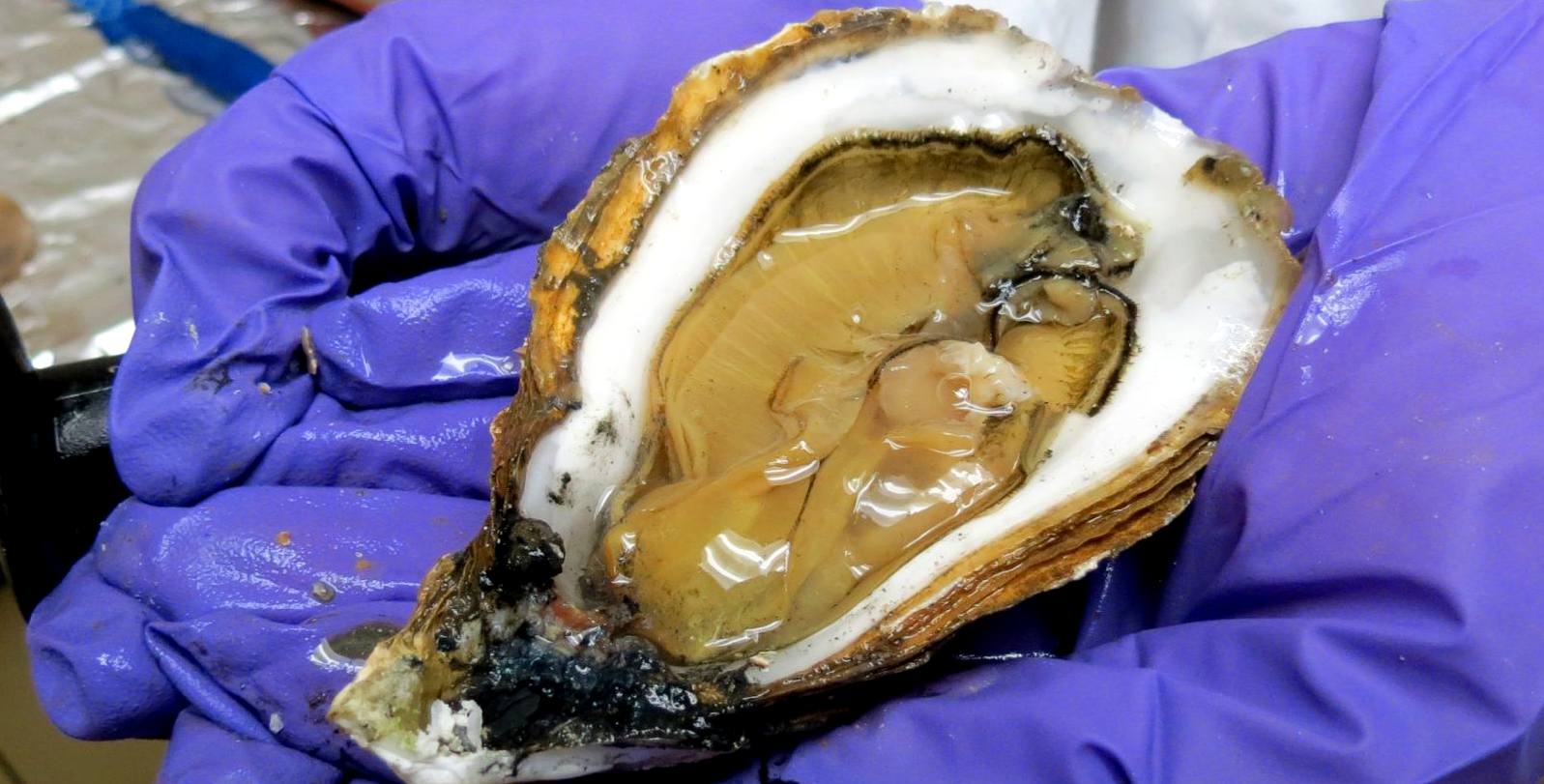
SHELLFISH
SURPRISE - Almost invisible to the human eye,
micro plastics are so small they are hard to detect - but they
are there in the razor clams and oysters sampled.
BRITISH
SEAFISHING.CO.UK
Microplastics are tiny pieces of plastic which end up in the world’s seas and oceans, causing environmental damage and as yet unknown effects on marine creatures and the wider ecosystems which support marine life. While microplastics have been an issue for some time, the topic has received an increasing amount of attention in recent years as concern over global plastic pollution – and its impact on human health – has risen.
Governments across the world are now beginning to take action to try and deal with microplastic pollution.
Microplastic particles range in size from 1mm across to as small as 0.0001mm in diameter. Microplastics are formed when larger pieces of waste plastic end up in the ocean. They begin to break down into smaller and smaller pieces and over time, releasing microplastics. With the amount of plastic ending up in the world’s seas every year there are major concerns over the amount of microplastic which will be released into the oceans over coming years. Indeed, the Great Pacific Garbage Patch is a collection of waste trapped in the North Pacific Ocean by currents and ocean gyres.
Other Forms of Microplastic Pollution: There are a huge range of other forms of microplastic pollution. Clothing is a little known type with certain kinds of fleeces and jackets releasing thousands of polyester fibres when they are washed which then also end up making their way into the world’s seas and oceans, with the Guardian claiming that a single clothes wash can release up to 700,000 fibres into the environment. Cosmetic wipes are also a significant problem as they also break down into microplastics. The Sunday Times reports that 920 million cosmetic wipes are used in the UK alone every year, with 296,000 tons of them used annually in the European Union, creating another source of microplastics.
In 2017 a survey of 279 British beaches found that 73% of beaches they looked at had plastic nurdles on them, with a 100 metre stretch of a beach in Cornwall having 127,500 nurdles present. In total an incredible 53 billion nurdles are estimated to escape into the UK environment every year. Nurdles are damaging to the environment as they break down into microplastics over time. They are also mistaken as food by fish and other sea creatures – something which is made even more dangerous as nurdles can absorb background chemicals which are present in the oceans. No one really knows what effects this will have on the long term health of fish which eat nurdles, or what impact it will have on people who then eat these fish. Car
tyres are another form of plastic
pollution, with the tiny pieces of rubber which break away every time a car is driven eventually making their way into the sea and adding to the microplastic problem.. Nurdles are plastic pellets used as the raw material in the manufacture of plastic. Due to the huge demand for plastic and plastic products billions of nurdles are shipped around the world every year, with many ending up in the sea during the manufacturing process or while they are being
shipped around the world.

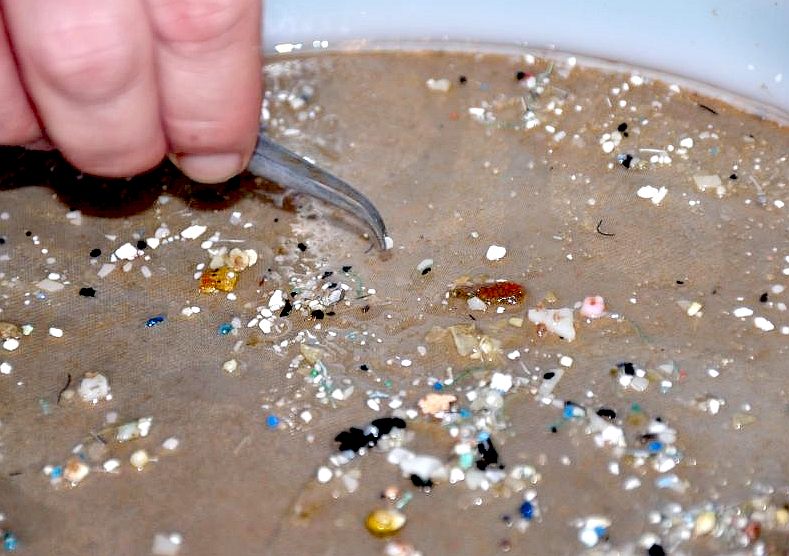

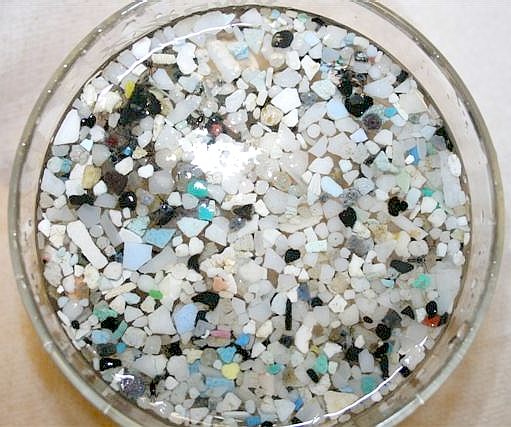

IMPACT ON HUMANS
There is now serious concern that there is so much plastic pollution in the seas and oceans that it is inevitable that humans will end up ingesting plastic through the
fish and seafood we eat. While the larger fish humans eat may not directly eat microplastics they may accumulate microplastics in their bodies when they are immature fry, or through feeding on smaller fish which are full of microplastics. A study in the science journal Nature found that a quarter of fish and shellfish bought at markets in Indonesia and California contained plastic, while researchers at the University of Ghent in Belgium have calculated that people eating shellfish on a regular basis will consume 6,400 pieces of microplastic a year. A small proportion of these will accumulate in the human body and there has yet to be any substantive research carried out to understand the long-term effects this will have on
human health.
It is not just microplastics which are an issue. Research carried out by the University of Arizona found that chemicals used in the manufacture of plastic may “may migrate into fish flesh and thus edible parts of seafood” and in accumulated concentrations they may be harmful to humans. Some very harmful chemicals are found in microplastics.
Persistent Organic Pollutants (POPs) are chemicals found in pesticides, flame retardants and electrical insulation which are resistant to environmental degridation. While many of these have been banned since the 1970s they will remain present in sea water for decades. Once plastic ends up in the ocean these chemicals can be absorbed into microplastics which are then consumed by fish and shellfish. Research by the University of Exeter found that plastic found off the coast of Japan had chemical levels over one million times higher than that found in the surrounding sea water.
The issue of both microplastic and chemical ingestion in fish very much affects the
UK, with the
Daily Mail quoting a report which found that 30% of fish in the
English Channel had some form of plastic in their bodies, and over 80% of scampi sold in the UK also contained plastic. Microplastic pollution is a truly global problem, with microplastics even being found frozen into arctic ice
and in deep sea ecosystems at depths of 6000ft (1820 metres).

ABC
NEWS NICOLE CHETTLE - This map shows the number of microplastics per 100 millilitres of wet sediment found at 27 sites across Sydney
Harbour.
ABC
NEWS - SYDNEY HARBOUR, AUGUST 2014
The bottom of Sydney Harbour has been contaminated by widespread microplastic pollution which could be entering the food chain, scientists say.
Professor Emma Johnston from the Sydney Institute of Marine Science said the microplastics, or fragments of plastic less than five millimetres long, represented the "emergence of new contaminants in our harbours and waterways".
In the first study of its kind, 27 sites were tested across the harbour, with researchers discovering up to 60 microplastics per 100 milligrams of sediment.
The environmental effects of the contaminants are largely unknown, but there have been moves to ban their use in products overseas.
Professor Johnston said some of the microplastic contamination was coming directly into the harbour.
"For example when we wash our fleecy jackets in the washing machine, lots of particles of microplastics, thin threads, come off and enter our waterways," she said.
"But there are also microplastics from facial scrubs and there are breakdown products from macro debris, like plastic bags or plastic bottles."
A PhD candidate at the University of New South Wales, Vivian Sim, said several hotspots were identified and the worst-affected area was in the pristine-looking waters of Middle Harbour.
"Something interesting is going on here, but we're not sure what," she said.
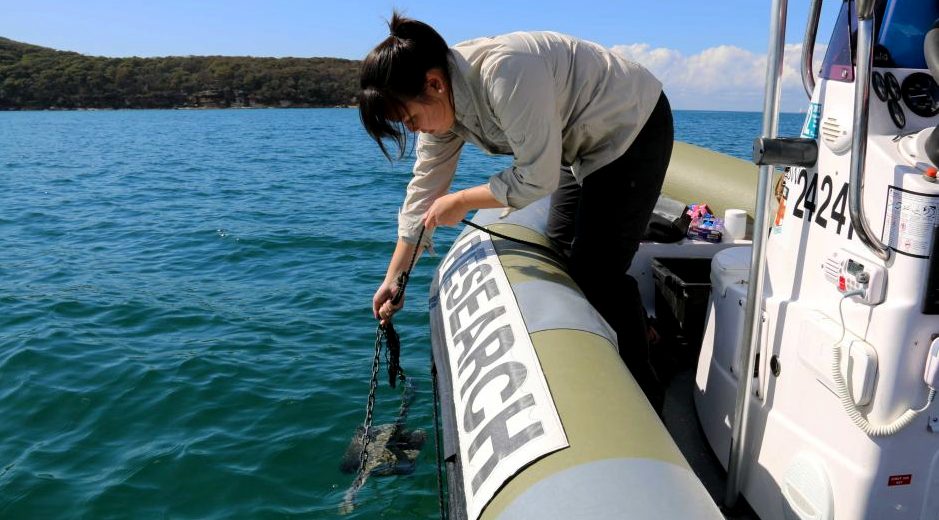
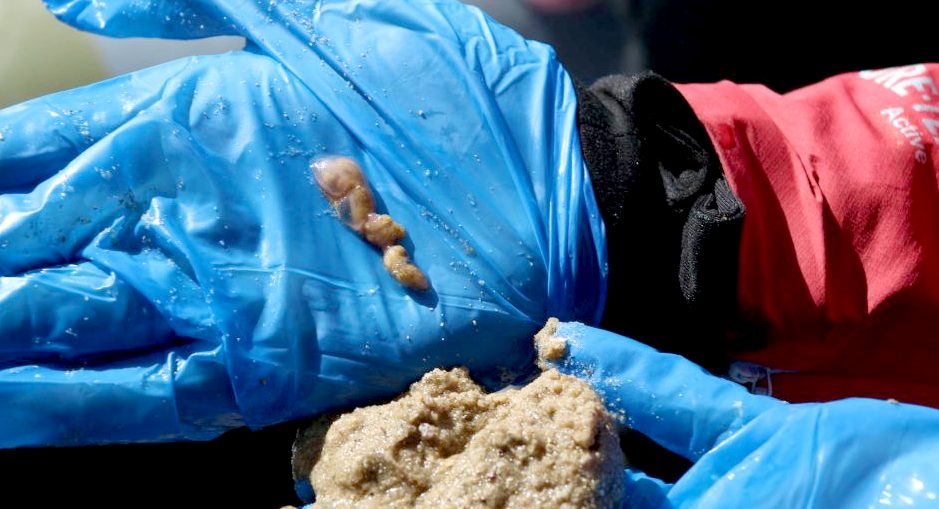
ABC
NEWS NICOLE CHETTLE - [TOP] Vivian
Sim, a PhD candidate working on microplastics at UNSW. [LOWER]
A researcher holds a peanut worm that has ingested sand possibly
contaminated with plastic.
RISK OF CONTAMINATING FOOD CHAIN
In Middle Harbour, microplastic threads were more common than flakes or balls, but it was unclear where they came from.
"We should be worried about it," Ms Sim said.
"We actually managed to pull up a sipunculid worm today.
"It's got sand going through all of it, so you can see that it's ingesting it.
"So if your microplastic fragments are as small as a sand grain, then [the worm] is going to take up the plastics and contaminants, and then if something else comes along and eats that worm it's going to go further up the food chain."
It was not clear what impact microplastics were having on the organisms that were eating them, but Professor Johnston said some contained materials such as flame retardants.
"We actually don't know anything about their concentration or what their ecological effects are," she said.
Ms Sim was looking to complete her research this year, but the Sydney Institute of Marine Science said the broader investigation would probably take four years.
Around the world, cosmetic manufacturers are responding to concerns about microplastics and several are phasing out the use of artificial cleansing beads.
Unilever said it would stop using them worldwide by January 2015.
In the United
States, Illinois has banned the production and sale of plastic microbeads in personal care products.
"Moves like that will actually end up with far greater effects in our marine systems than we recognise," Professor Johnston said.
"We need to make those changes now to reduce the input of microplastics into waterways like
Sydney Harbour."
She said more research was needed to determine the impact of microplastics on the harbour.
By Nicole Chettle ABC news
LINKS
& REFERENCE
National
Geographic – Eight
Million Tons of Plastic Dumped in Ocean Every Year
The Washington Post – By
2050, there will be more plastic than fish in the world’s oceans, study says
The Guardian – ‘Great
Pacific garbage patch’ far bigger than imagined, aerial survey shows
The Daily Mail – Hidden
in your daily facial scrub: Up to 94,500 tiny microbeads which are deadly to
marine life
The Daily Mail – Is
your fleece killing marine life? Warning over jumpers that release thousands
of toxic fibres every time they’re washed
The Guardian – Single
clothes wash may release 700,000 microplastic fibres, study finds
The Sunday Times, The War on Face Wipes, 30/10/2016
BBC News – Plastic
‘nurdles’ found littering UK beaches
UK Business Insider – By
2050, the oceans could have more plastic than fish
The Guardian – Microplastics
killing fish before they reach reproductive age, study finds
Environmental Science & Technology Journal – Effect
of microplastic on the gills of the Shore Crab Carcinus maenas
Nature – Anthropogenic
debris in seafood: Plastic debris and fibers from textiles in fish and
bivalves sold for human consumption
Environmental Pollution Journal – Microplastics
in bivalves cultured for human consumption
The Guardian – Fish
for dinner? Your seafood might come with a side of plastic
The Daily Mail – A
poison worse than any spill: How a third of fish caught in the English Channel
have microplastics in their guts
Nature – Microplastics
in Arctic polar waters: the first reported values of particles in surface and
sub-surface samples
The Mirror – Scientists
‘astonished’ to find micro-plastics polluting oceans at a depth of 6,000ft
The Guardian – England’s
plastic bag usage drops 85% since 5p charge introduced
Sky.com – Plastic
bag tax ‘fantastic news for marine wildlife’
Bacardi Limited Website – Bacardi
Initiates a ‘No-Straw’ Movement to Reduce Waste
The Telegraph – Plastic
bottle ‘tax’ could be introduced to tackle waste
Sky.com – Supermarkets
urged to have plastic-free aisles
Daily Mail – No
more plastic in shower gels and face scrubs: Cosmetics firms pledge to remove
harmful microbeads to protect the oceans
BBC News – Plastic
microbeads to be banned by 2017, UK government pledges
Daily Mail – Jennifer
Aniston ‘should blush with shame’ over facial scrub adverts
The Guardian – Ministers
explore applying microbead ban to household products
Daily Mail – Now
ban the microbeads in make-up: Controls on ‘plastic poison’ in toothpaste
and body scrubs MUST be extended to cover cosmetics too
The Guardian – Could
a new plastic-eating bacteria help combat this pollution scourge?
The Guardian – Shampoo
bottle made from ocean plastics hailed as ‘technological breakthrough’
The Telegraph – Our
seas have become a plastic graveyard – but can technology turn the tide?
Plasticstoday.com – Plaxx,
a clean substitute for fossil-based heavy fuel oil?
New Scientist – Could
a vast rubber boom clean up tonnes of ocean plastic?
The Guardian – Too
good to be true? The Ocean Cleanup Project faces feasibility questions
Huffington Post – Why
Use Microbeads When The Alternatives Are Better?
Fish2Fork.com – United
Nations bids to stop plastic pollution killing marine wildlife
http://www.seagrant.noaa.gov/
http://seagrant.oregonstate.edu/
https://www.flickr.com/photos/oregonseagrant/sets/72157685405628133/
https://waste-management-world.com/a/video-impact-of-micro-plastic-waste-on-oregons-shell-fish
http://www.abc.net.au/news/2014-08-21/microplastics-found-in-sydney-harbour-floor/5686472
http://britishseafishing.co.uk/microplastics-and-ocean-pollution/
http://www.express.co.uk/life-style/top10facts/556136/Top-10-facts-about-plastic
https://sustainabledevelopment.un.org/sdg14
http://wef.ch/plasticseconomy
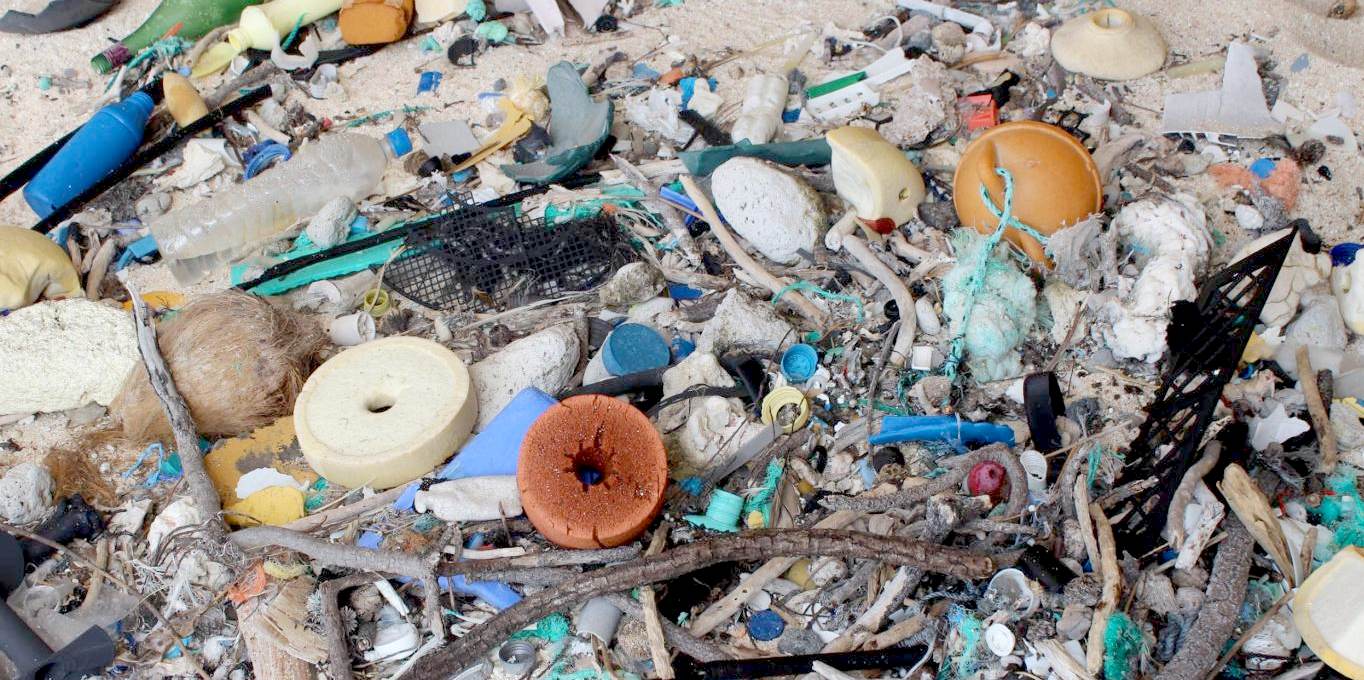
THE
INDEPENDENT HENDERSON ISLAND - Beaches of a remote British island in the South Pacific are littered with an estimated 37.7 million pieces of plastic,
only discovered in 2017.
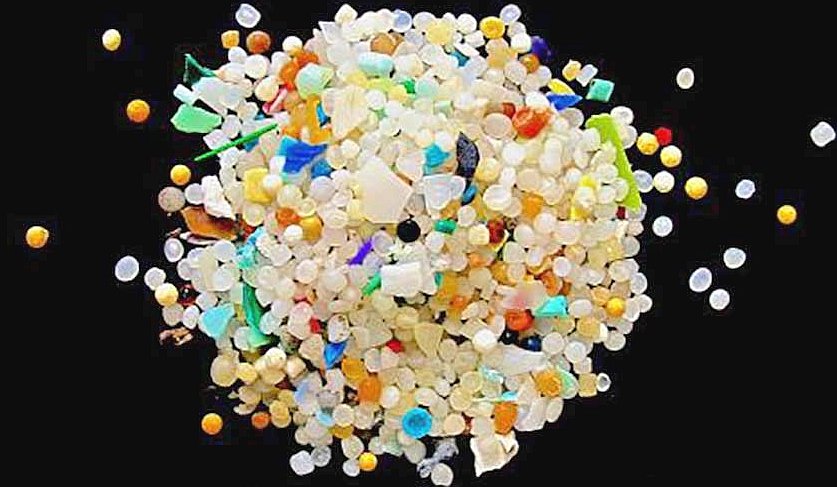
ABS
- BIOMAGNIFICATION
- BP DEEPWATER - CANCER
- CARRIER BAGS
- CLOTHING - COTTON BUDS - DDT - FISHING
NETS
FUKUSHIMA - HEAVY
METALS - MARINE LITTER
- MICROBEADS
- MICRO
PLASTICS - NYLON - OCEAN GYRES
- OCEAN WASTE
PACKAGING - PCBS
-
PET - PLASTIC
- PLASTICS
- POLYCARBONATE
- POLYSTYRENE
- POLYPROPYLENE - POLYTHENE - POPS
PVC - SHOES
- SINGLE USE
- SOUP - STRAWS - WATER
This
website is provided on a free basis as a public information
service. copyright © Cleaner
Oceans Foundation Ltd (COFL) (Company No: 4674774)
20120. Solar
Studios, BN271RF, United Kingdom.
COFL
is a charity without share capital.
|












